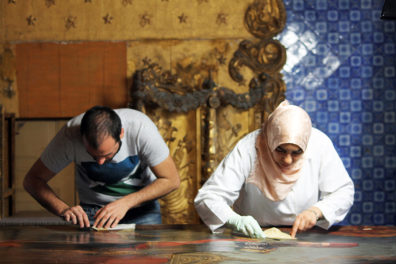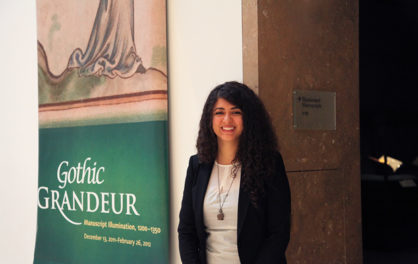
Saint John the Evangelist in a 14th-century German manuscript; Marilyn Monroe by an unknown photographer.
The luxuriant locks sported by this medieval figure might seem to say more “Marilyn Monroe” than “Saint John.” Both he and the movie star sport hairstyles from the glamorous ‘40s—in the saint’s case, the 1340s.
In the Middle Ages, it was thought that Saint John the Apostle wrote both the Gospel of John and the Book of Revelation, known as the Apocalypse. According to Christian tradition, John was the youngest of the disciples, and the most beloved by Jesus. In medieval art, while the other Apostles are usually shown as bearded, balding older men, John is shown as a beautiful beardless youth. Here his abundant, curled hair is another indicator of his youthfulness. It’s a head of hair even Marilyn would be jealous of.
The leaf, a recent acquisition by the Getty Museum, went on view this morning in the new exhibition Gothic Grandeur: Manuscript Illumination, 1200–1350, which runs through May 13. I’ll be adding more entries to The Manuscript Files on details in these manuscripts over the course of the show.

Saint John the Evangelist Writing, German, about 1340–50. Tempera colors, gold leaf, and ink on parchment, 17 7/8 x 12 in. The J. Paul Getty Museum, Ms. 108, verso




Thanks for the beautiful image!
Isn’t the miniature a copy from or somewhat related to the biblia pauperum with an apocalpyse that was illuminated in Erfurt and now is in Weimar (Anna Amalia library, ms. fol. max. 4) ? amazing!
This is a great idea, Beth, and a wonderful acquisition! I hope I get a chance to see the exhibition sometime in the spring.
ts- What a good eye you have! Yes, this leaf comes from a series of individual leaves, others of which are held at Nuremburg, Germanisches Nationalmuseum, Kupferstichkabinett, (Hz. 1279-1283 and Inv.-Nr. 6412). These leaves once came from a complete manuscript that probably served as the model for the Wiemar manuscript.